The crassula muscosa is a unique plant that will be the biggest conversation starter in your home.
Read on for more information about this succulent plant, as well as a complete care guide to decide if you wish to add this plant to your collection of succulents.
Table of Contents
Background
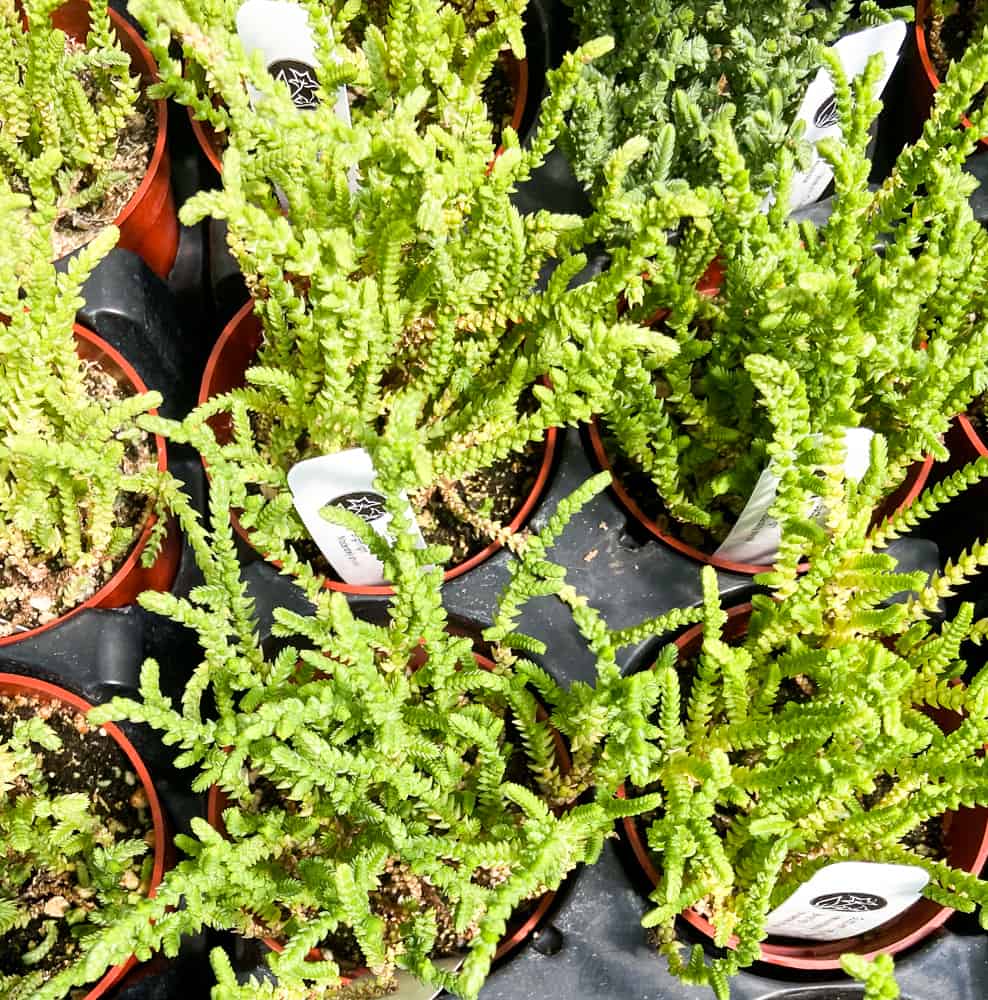
Unusual, yet beautiful: the Crassula muscosa is a head-turning plant that is originally native to the regions of southern Africa growing in well draining rocky quartz fields.
The crassula muscosa plant is also commonly referred to as the watch chain plant, rattail crassula, or the zipper plant.
It is most commonly called the watch chain plant and the Latin word muscosa means “mossy” which refers to the plants moss like appearance. The tiny tight leaf arrangements resemble the links of jewelry or watch chain.
True to its nickname, the crassula muscosa’s branches are adorned with small, succulent leaves that form a geometric chainlink pattern up and down the branches. This plant is fast-growing and will reach a length of roughly 12 inches long when matured.
Unfortunately, this plant is known to be toxic to both humans and animals. Caution is advised when keeping this plant near curious children or pets.
Crassula Muscosa Watch Chain Care
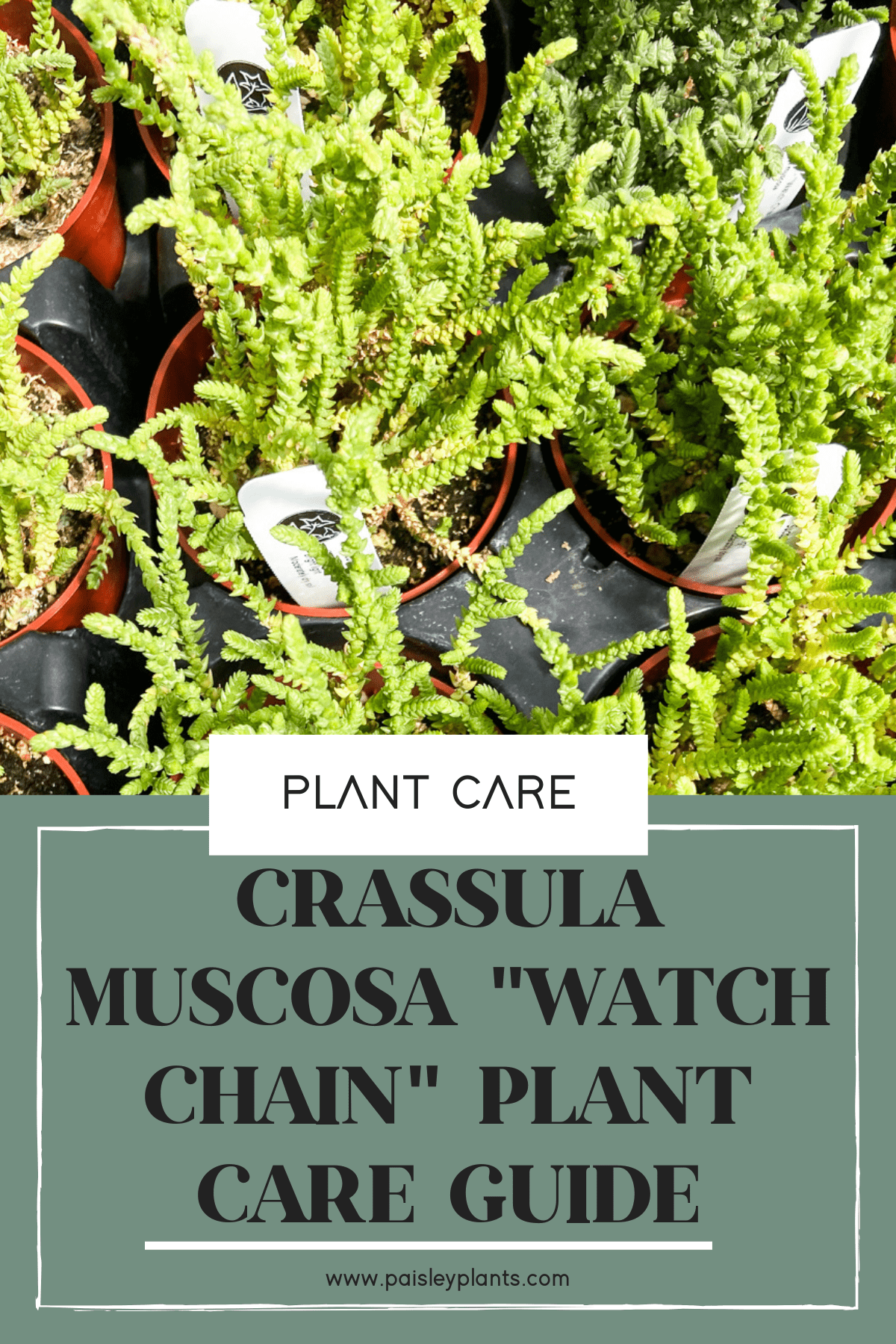
Sun & Light
Your crassula muscosa will thrive when exposed to bright, indirect light. Avoid direct sun as the leaves of the muscosa are sensitive and will burn in direct light.
These plants also grow well under full spectrum LED grow lights if you don’t have the proper sunny window to place them in. About 4 to 6 hours of light per day is the perfect amount for a healthy plant.
The watch chain plant will tolerate partial shade conditions, though this is not ideal if you want your plant to achieve its maximum growth rate. The watch chain crassula needs the right amount of sunlight and good ventilation or the leaf segments can become brown, hard, and woody and they will drop off more readily.
Soil Type
The ideal soil type for the crassula muscosa is a very well-draining soil. Like most other succulents, the muscosa does not like to sit in wet soil, so there must be a high content of gritty, well-draining material.
Place a tray beneath the pot to catch the excess water. Do not leave the water in the tray for more than 10 – 15 minutes to prevent root rot. You can also use pebbles on a tray to aid in good ventilation and evaporation of the excess water.
Most store-bought soil mixtures tailored towards cacti/succulents will work very well for this plant. However, many plant owners prefer to mix their own potting soil. You can make your own mixture at home with the following ingredients:
- Three parts loam
- One part grit (you can also use perlite)
- One part horticultural sand
These ingredients together will retain just enough moisture to keep your plant fed, while still draining out the excess moisture your plant does not need.
Water
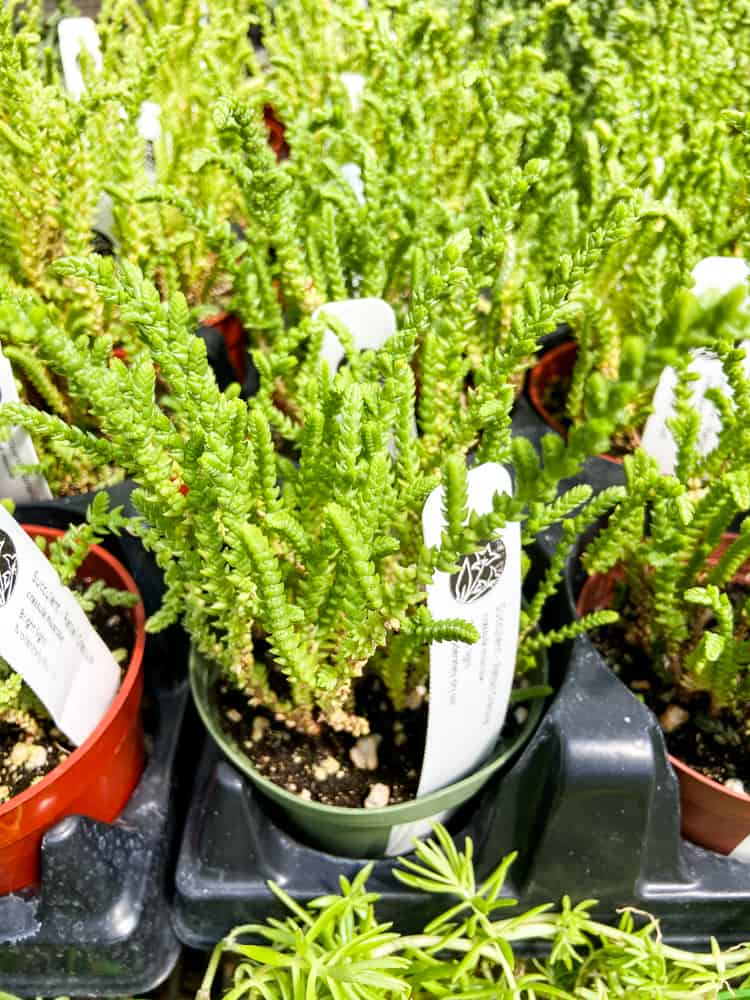
The crassula mucosa’s natural habitat is in warm, rocky locations that receive sparse amounts of water. Keep in mind that these are succulents and do not require much water to keep them alive.
A good rule of thumb is to wait until the soil has dried before rehydrating your plant. Most plant owners stick a finger into the soil to gauge the soil’s dryness. If the soil is dry past 2 inches, then it is time to water your plant. Remember that a consistent watering schedule is important to maintain healthy plants.
The watering schedule may vary from season to season. They may require more frequent watering in spring, summer and early fall, but less in winter. This plant is a winter flowering type plant, so may only need to be watered once a month during the winter months.
With succulents, it is often better to underwater your plant, rather than to overwater. These plants are highly sensitive to overwatering and it can lead to detrimental diseases, such as root rot, so remember it is better to underwater than to overwater.
Fertilizer
While fertilization is not a necessity when it comes to caring for your watch chain succulent, it is extremely helpful in encouraging strong, healthy growth. The best time to fertilize your succulent is when it is in active growth (spring and summer).
You should fertilize your watch chain plant once every two to three weeks in the spring and summer. There is no need to fertilize in the winter because, although these plants are winter flowering, they are not winter growing.
Select one of the many fertilizers that are specially tailored to the growth of succulents. You can opt to feed your watch chain plant with a controlled-release fertilizer, or a weakly diluted liquid fertilizer. Be cautious when handling fertilizer and follow the specific instructions on the package; improper usage of fertilizer can have negative consequences.
Temperature & Humidity
As a succulent plant native to Africa, the crassula muscosa watch plant enjoys warm air temperatures and low humidity. The ideal air temperature in your home should be around 70° to 80° F for a comfortable plant.
Avoid temperatures lower than 65° F; place your crassula away from cold areas such as air conditioning vents. Most watch chain plants will tolerate normal household humidity levels of around 50% to 70% humidity.
Pruning & Maintenance
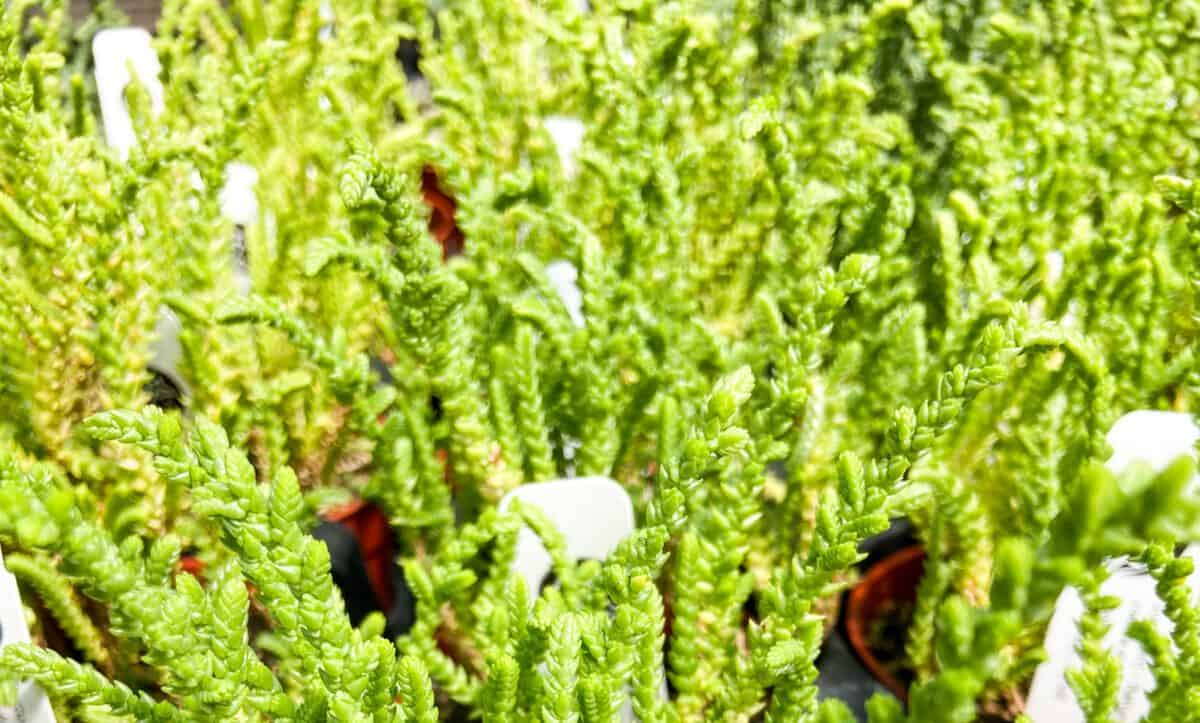
Pruning your watch chain plant is helpful in both controlling its growth pattern as well as encouraging new branch development. The ideal time to prune your crassula is during the springtime in order to prevent unruly growth. The watch chain plant is a low maintenance plant but can easily be propagated from cuttings.
We always recommend sterilizing your pruning tools by wiping them with rubbing alcohol. Using unsterilized pruning shears can carry bacteria that could pass onto your otherwise healthy plant.
Choosing a Container & Repotting
Because the crassula muscosa is a succulent plant, it is important to have a container with ample drainage. A planter with multiple drainage holes is a must-have with these types of plants.
Drainage will help the root system expel unnecessary water, leaving the crassula hydrated but not waterlogged. It is best to wait a few days to water your plant after repotting to allow the roots to settle into the soil.
For succulent plants, it is also recommended to select a planter made from a porous material such as terra cotta. A porous container will absorb the excess water that does not expel from the drainage holes.
The crassula muscosa is a fast-growing plant, so anticipate having to repot your plant every 1 to 2 years. When repotting your crassula, repot it in a planter that is slightly larger than the previous pot to avoid transplant shock.
Using a pot that it approximately one inch larger than the current pot is a good rule to follow when repotting your watch chain plant.
How to Propagate a Crassula Muscosa “Watch Chain Plant”
The crassula muscosa can easily be propagated via stem cuttings. Follow these steps to multiply your watch chain plant:
- Select a healthy portion of your plant. This stem should be at least 2 to 3 inches in length.
- Using sterilized pruning shears, remove this stem section from the main plant.
- Fill a small plant pot with well-draining soil and lightly dampen the soil.
- Transplant the stem cutting into the potting mix and place the pot in a location with bright, indirect light.
- Every few days, give your juvenile plant water to keep it lightly moist, but not soaked in water.
- It takes a few weeks for roots to establish in the soil. The best signs of a successful propagation is new growth. You can also test by giving your stem a gentle tug; if you’re met with any resistance, then that means the propagation was a success!
- When the propagation has completed, reduce your watering to only once a week and care for your new crassula muscosa as you normally would any other watch plant.
Common Pests
Aphids are one of the most common pests that are associated with the crassula muscosa. Aphids are tiny, green pests that latch onto the leaves and stems of plants and suck out the nutrients. These pests leave brown patches where they feed, as well as a sticky substance that can attract ants.
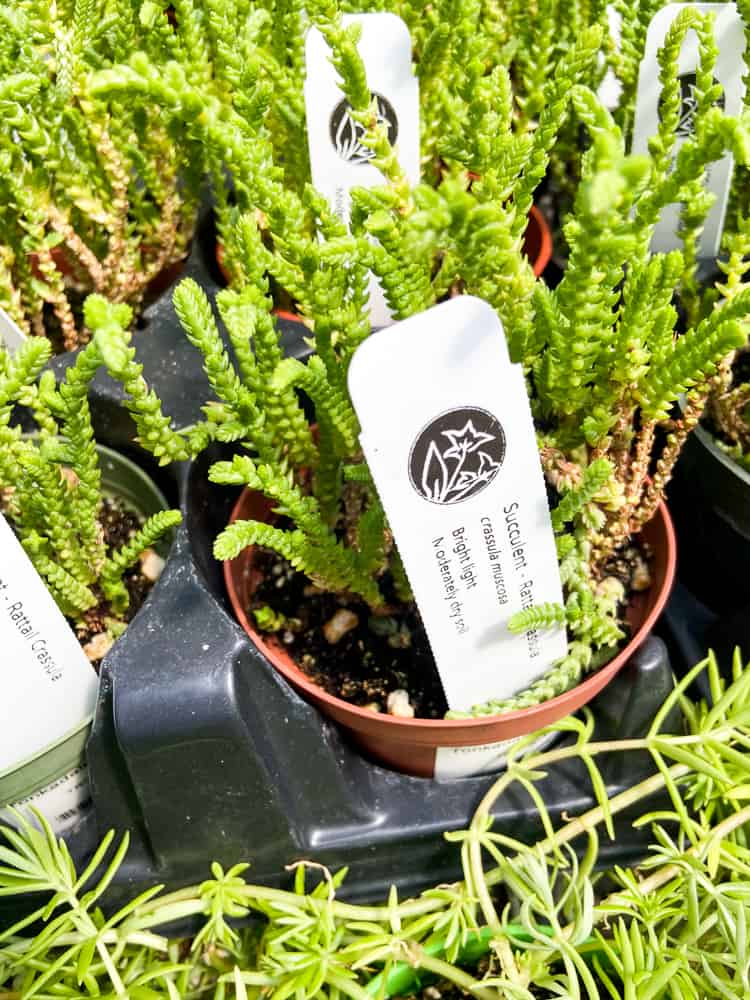
While aphids are an incredible nuisance to plant owners, they can be swiftly curtailed using simple solutions. Many gardeners swear by using neem oil to control their pest problem.
Spray neem oil onto the surface of your plant; this is not a one-time fix, and will most likely require 2 or 3 rounds of spray to completely eradicate your pest problem.
In addition, aphids can be suffocated by dusting all-purpose flour onto your plant. The flour constipates aphids, which leads to their downfall.
Generally, pests do not attack healthy plants. The best way to prevent pests all together is to properly care for your plants and closely monitor them for any signs of distress.
Common Diseases
As a succulent, the crassula muscosa is sensitive to overtly moist conditions. Improper watering can lead to bacterial and fungal diseases brought on by too much soil moisture. The most prominent of these diseases is root rot.
The excess moisture that is trapped within the root system can cause the roots of the crassula plant to corrode and rot, which will slowly kill the plant itself. If your succulent crassula muscosa is wilting and discolored, these are telltale signs of root rot.
Luckily, root rot can be easily treated as long as it is caught early. Follow these steps in order to treat your plant:
- Remove the crassula from its pot and inspect the root system. Rotten roots are soft in texture and have turned near-black from the rot.
- Using a sterile pair of shears, cut away at all signs of rot.
- When all rot has been cleared, repot your crassula in a sterile plant pot that has multiple drainage holes. Fill the planter with well-draining soil that is suitable for succulents.
- For the next couple of weeks, keep the soil lightly moist to lessen the risk of shock.
Watch Chain Plant FAQ
When your crassula does not receive enough sunlight, it tends to get leggy and stretch out. Keep in mind that your watch chain plant should be receiving 4 to 6 hours of light per day for optimal growth conditions.
While the crassula muscosa may not have the same recognition that other popular succulent species have, it is not considered to be a very rare plant.
Crassula muscosa plants are available for purchase from online retailers for reasonable prices. In addition, this species is very easy to propagate. Once you own one crassula muscosa, you can use its stems to multiply your plant count tenfold.
Despite its exotic and geometric appearance, the crassula muscosa is a very beautiful and low-maintenance plant to own and care for. Growing crassula muscosa is an easy, affordable, and lesser known succulent and it may just be the plant for you.
Want more succulent fun? Check out these!
